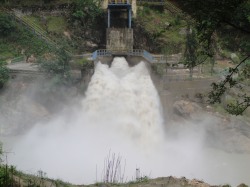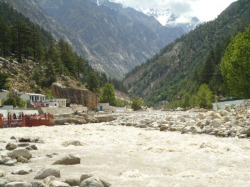Chardham Yatra
Haridwar is the gateway to the holy abode of Lord Vishnu (Hari). Located in Uttar Pradesh, this pious city is known for Kumbh Mela and the arrival of Kanwariyas in the month of monsoon. Being one of the most sacred places in India, it sees crystal clear nectar of river Ganga, who wards off all the evils of human. On the famous “Har Ki Pauri”, you will find numerous devotees taking bath in the holy Ganga water. On this Pauri lies “Brahma Kund”, where it says that Amrit carried by Garuda after Samundra Manthan fell a bit. That’s the reason; why dipping at Brahma Kund is considered as an important part of Hinduism.
In fact, Haridwar is considered as the opening to various religious places located in this side. This beautiful city is echoed by the aarti of Ganga Ji, either on the banks of Ganga or through the music shops present near the Har Ki Pauri. The most important thing to see as Har Ki Pauri is the aarti of Ganga Ji in the morning and evening. At this moment, the silver statute of Goddess Ganga is brought out on the banks to perform the puja. After the puja gets complete, the silver idol is taken back. Then,the Pundits give aarti to every individual present there.
The market near Har Ki Pauri is full of shops where you can get everything. From clothes to bangles, purses, accessories, music CD and various other decorative pieces and the stuff for puja, the markets has everything of your need. Apart from this, the market at Har Ki Pauri also takes you at the journey of Mansa Devi temple through ropeway trolley. Another attraction to check out is Chandi Devi temple and various other important temples located line wise near Har Ki Pauri. In order to make you see those temples, the autowalas take several people in one auto on a tour to them all.
Tourist Attractions in Haridwar
One of the much traveled tourist destinations in Indiafor pilgrims and vacationers alike, Haridwar offers several tourist sites to be explored. Located to the north, Hari-ki-Pairi (or Har-ki-Pairi) is taken as the city’s central point, where devotees come for a holy dip in the River Ganges. According to the legend this is actually where a drop of nectar fell as a result of the samudra manthan (churning of the oceans) – Mythically it signifies the start of the world.
Haridwar is a city of temples, monuments and forts – most of them displaying rich Hindu architectural culture. Some of them have been discussed as follows:
GAU GHAT
Of the many holy ghats, Gau Ghat is considered one of the most holy ghats. A dip at this ghat is considered holy and sins of slaughtering cows are washed off. It is also known to provide solace to those who have lost their loved ones and offerings of coconuts and rose petals are made at this ghat to provide peace to the departed soul. The ashes of Jawahar Lal Nehru, Mahatma Gandhi and Indira Gandhi were immersed at this ghat.
MANSA DEVI MANDIR
Mansa Devi Mandir, situated on top of a hill towards the center of Haridwar is reached either by cable car or by a road that runs up to the hill, starting from the Railway Road. The scenic landscape around the temple is the main attraction here.
CHANDI DEVI
The Chandi Devi Temple, situated atop the Neel Parvat, gives a panoramic view of the entire Haridwar town. The temple was built in the year 1929 by the then king of Kashmir Suchat Singh.
UDAN KHATOLA
The amazing Udan Khatola is a ropeway that is used to reach the temples on the hill. It is faster and easier way to visit the temples than by climbing the rugged terrain. It starts in the area close to Chandi Devi mandir and one can enjoy magnificent views of the low lying regions.
BHARAT MATA TEMPLE
The Bharat Mata Temple is a massive eight-storey structure consecrated in 1983. Each floor of the temple houses statues of different mythological and historical legends, religious deities, leaders and heroes who played important role in the formation of the modernIndia. The temple was founded by Swami Satyamitranand Giri.
SHANTI KUNJ
Shanti Kunj is another place to visit in Haridwar. It is the most important centre for the Gayatri followers all over India. The temple here houses 24 images of Gayatri. Shanti Kunj is also famous for yoga practices.
HAR-KI-PAURI
Har-Ki-Pauri is regarded as one of the major attractions of Haridwar. It is a sacred ghat built by the then King Vikramaditya in the memory of his brother Bhartrihari. This sacred bathing ghat is also known as Brahmakund. Thousands of devotees come here to take a holy dip in the riverGanga during the Kumbh Mela.
KUSHAVARTA GHAT
The Kushavarta Ghat was built by Queen Ahilya Bai Holkar, the Maratha Queen to perform ‘Shraddha’ of loved ones. Legends link this ghat to Dattatreya, a renowned saint, who came to the ghat to meditate. It was on this ghat that he stood on one foot in penance for 1000 years. It is about 500 meters from Har Ki Pauri and is crowded all through the year.
MAYA DEVI TEMPLE
The Maya Devi Temple holds great religious importance for the follower of Hindu religion. The temple is also regarded as one of the Siddhapethas dedicated to the Adhisthatri Devi of Haridwar.
BABA RAMDEV'S PATANJALI YOGPEETH
Patanjali Yog Vidhyapeeth is setup on approximate 35 acers of land and has been planned as multi-service unit where Yoga Science Residential campus and Medical inventions is been held in the holy presence of Swamiji. More than 5000 participants been accommodated at a time with dining facilities.
BAZAARS

























